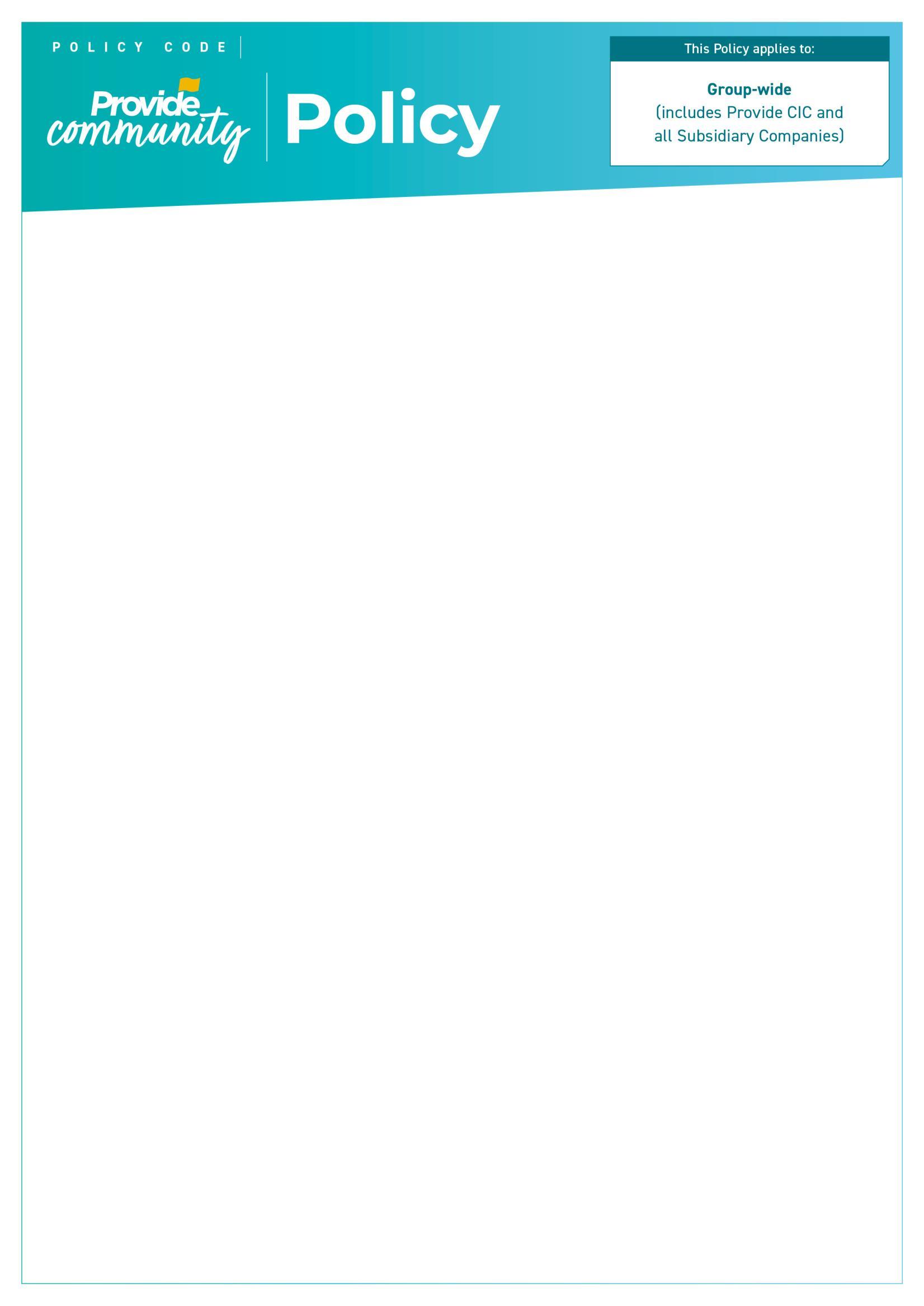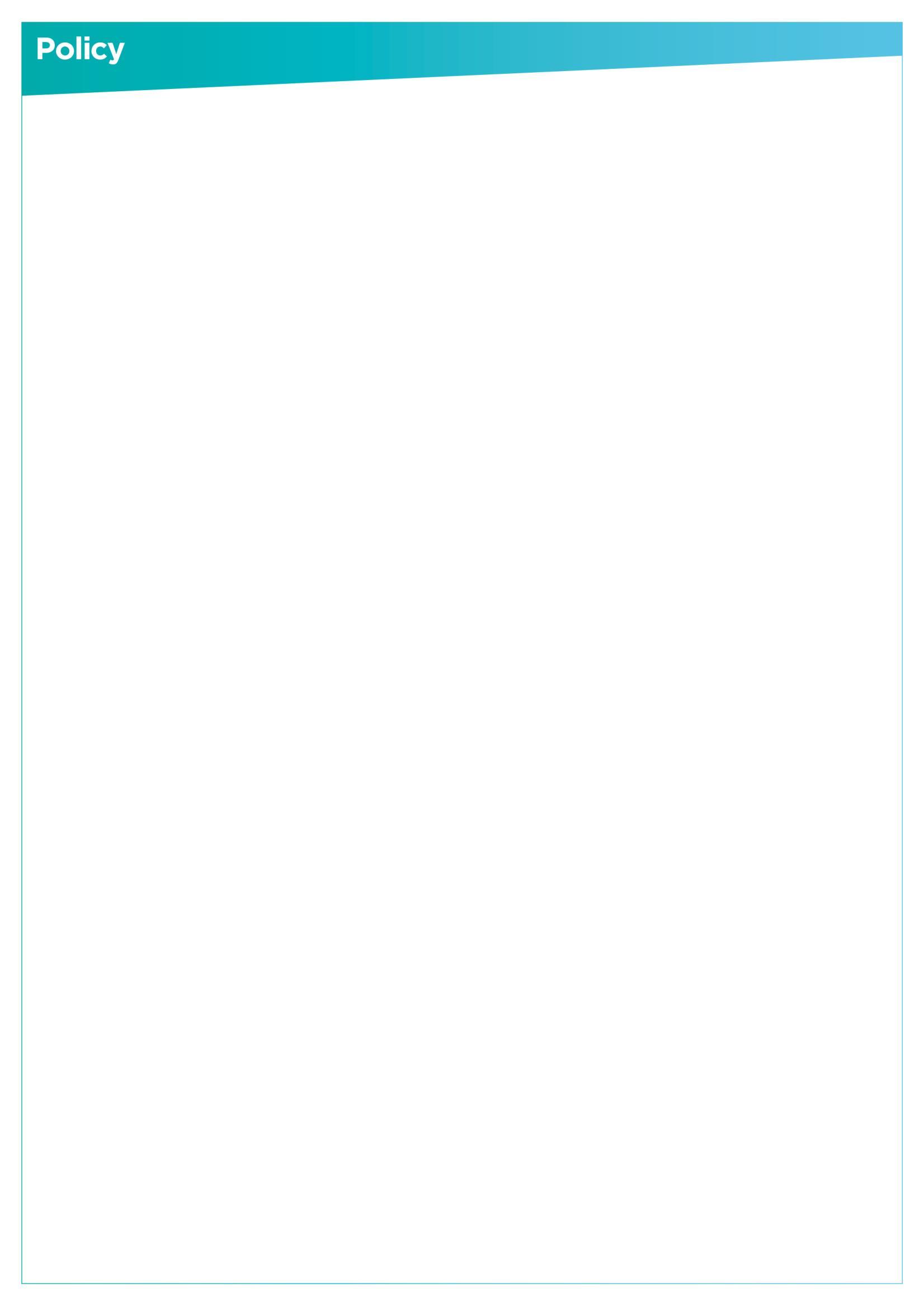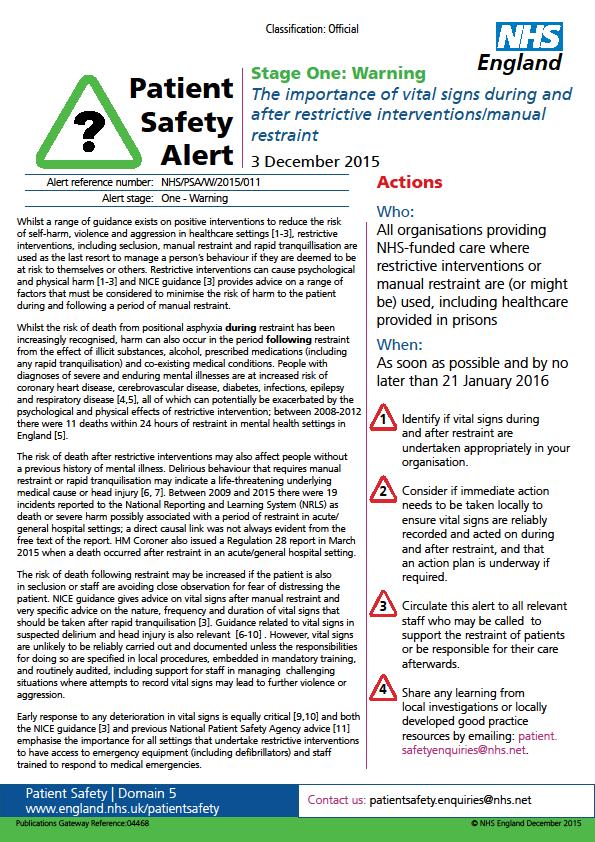Provide Group Safeguarding Assurance Oversight Structure
Provide Group Business Board Meets Bi -Monthly
• Receives escalations from QSC
• Discusses risks and areas for action where gaps in performance are identified with due regard to risk appetite and tolerance
Provide Group Business Quality & Safety Committee Meets Bi -Monthly
• Receives escalations from QPLT
• Identifies risks and areas for action where gaps in performance are identified
• Escalates exceptions to the Board
Provide Group Quality Provide Leadership Team Meets Monthly
• Reviews Quarterly Safeguarding Report from SSG quarterly
• Makes recommendations for action and monitors where gaps in performance are identified
• Escalates exceptions to QSC
Provide Group Strategic Safeguarding Group Meets Quarterly
• Reviews performance against safeguarding standards and statutory and regulatory compliance
• Devises and maintains oversight of safeguarding strategy for the Provide Group
• Agrees and Ratifies policies and training Produces a quarterly assurance report for QPLT
•
1. Introduction
This Policy sets out the roles and responsibilities of Provide Community Group in working together with other professionals and agencies in promoting service users’ welfare and safeguarding them from un-necessary/inappropriate restraint. Provide Community Group believes that the welfare of service users is paramount and that they have a right to feel safe and protected from any situation or practice that results in them being harmed or at risk of harm. Provide Community Group is committed to maximise people’s choice; their control and inclusion in care/decision making; and protecting their human rights. Provide Community Group believes these are important for meeting their individual needs and reducing the potential for abuse (CQC; Standard 7; 2010). Provide Community Group welcomes the publication of the Restraint Reduction Network Training Standards (RRN Jan 2020) These standards have been written to ensure all restraint training promotes human rights and supports a cultural change necessary to reduce reliance on restrictive practices.
See Link to RRN standards The Restraint Reduction Network Training StandardsRestraint Reduction Network
2. Purpose
Provide Community Group are committed to:
• Ensuring the welfare of service users is always paramount
• Maximising people’s choice, control and inclusion and protecting their human rights.
• Promoting person centred, best interest and therapeutic approaches to supporting people when they are distressed.
• Increasing understanding of the causes of behaviour and recognition that a challenging behaviour is the result of an unmet need.
• Working in partnership to safeguard vulnerable adults and children
• Ensuring safe and effective working practices are in place
• Providing all staff with Human Rights based Restraint Training
3. Definitions
Restraint
‘Restraint’ is an act carried out with the purpose of restricting an individual’s movement, liberty and/or freedom to act independently. This may or may not involve the use of force, or resistance by the person being restrained, and may include indirect acts of interference for example removing someone’s walking frame to prevent them moving around. (Equality and Human Rights Commission 2019)
Restrictive interventions
are defined as a range of different approaches that limit an individual’s movement, liberty and/or freedom to act independently (Department of Health, 2014). Restrictive interventions include using the physical environment to stop a person from doing something i.e. bed rails, locking a door, using postural seating to contain someone, use of a harness in a wheelchair.
Reactive Strategies
Are strategies used to support a person when they behave in a way that challenges NICE guidelines (NG11) 2020
Types of Restraint
Mechanical restraint involves ‘the use of a device (e.g. belt or cuff) to prevent, restrict or subdue movement of a person’s body, or part of the body, for the primary purpose of behavioural control’ (Clinical Quality Commissioner, 2015).
Clinical holding involves immobilisation, which may be by splinting, or by using limited force. It may be a method of helping children (and adults), with their permission, to manage a painful procedure quickly or effectively (Royal College of Nursing, 2010).
Chemical restraint refers to the use of medication which is prescribed and administered for the purpose of controlling or subduing disturbed/violent behaviour, where it is not prescribed for the treatment of a formally identified physical or mental illnesses (CQC, 2015).
Psychological restraint refers to practices that may be used covertly such as hiding medication in food or influencing a person’s choice e.g. ‘you don’t want to go out today do you?’
Challenging Behaviour any non-verbal, verbal, or physical behaviour exhibited by a person which makes it difficult to deliver good care safely. (NHS Protect, 2013)
Challenging Behaviour Communication of an unmet need. (Alzheimer’s Society UK 2020)
4. Duties
The Provide Community Group Community Group Chief Executive and wider Board members have key roles and responsibilities to ensure the Organisation meets requirements set out by Statutory and Regulatory Authorities such as the Department of Health & Social Care, Commissioners and the Care Quality Commission.
The Group Chief Executive has overall responsibility to have processes in place to:Ensure that staff are aware of this policy and adhere to its requirements and that appropriate resources exist to meet the requirements of this Policy.
The Group Chief Officers are responsible for ensuring that all operational managers in their area are aware of this policy, understand its requirements and support its implementation.
Team Managers are responsible for implementing the policy and ensuring that relevant assessment tools are readily available to allow staff to carry out the duties prescribed in this policy.
Ward/Department Managers and other senior ward staff are responsible for recognising any instance of possible Restraint/Deprivation of Liberty in the clinical area and ensuring that all Provide Community Group and Local authorities’ policies and procedures are followed.
All Staff have a responsibility to provide safe and effective care, while working within the law and respecting the human rights of individuals. Each person is accountable for the decisions they make and the consequences of those decisions.
All staff have a duty to follow the guidance in this policy and this includes:
• All Provide Community Group commissioned services (adult and children)
• Provide Community Group Specialist Learning Disability services.
• Services that work in partnership with Provide Community Group
• Temporary, voluntary, contracted, or self-employed staff working on behalf of Provide Community Group
• Bank/agency staff working on behalf of Provide Community Group
5. Legal Framework
All staff must ensure that any restraint or restrictive practice should only be carried out where it is legally and ethically justified.
The use of all forms of physical intervention and physical contact are governed by criminal and civil law. The unwarranted or inappropriate use of force may constitute an assault. (DOH 2018) Restraint must be unavoidable to prevent serious harm to a person and it must be the least restrictive option.
Staff must draw on several legislative frameworks and Provide Community Group Policies to work within, including:
• The Human Rights Act 1998 & the European Convention on Human Rights (Appendix A)
• The Mental Capacity Act 2005, including the Deprivation of Liberty Safeguards
• The Mental Health Act 2007
• The Equality Act 2010
Staff must always judge whether restrictive interventions are acceptable and legitimate based on all presenting circumstances. All use of restrictive interventions must be escalated to the management and safeguarding team; Datix must be completed; immediate action must be taken as per Provide Community Group safeguarding Policy.
6. Applying Restrictive Intervention
Restrictive intervention or Restraint may include physically preventing a patient from doing something (pulling them away from a situation), using the physical environmental to contain someone (use of bed sides, locking a door), threatening or taking an action to control someone’s behaviour (calling the police) or medication may be used as a restriction to manage the service user’s behaviour or restrict his/her freedom of movement.
Restrictive interventions should only be used where there is a real possibility of harm to the person or to staff, the public or others. All staff must have positive and proactive approaches to ensure physical interventions are only ever used as a last resort when all other alternatives have been attempted and only then for the shortest possible time.
To reduce the needs for restrictive intervention/restraint staff must understand that a person’s ‘challenging behaviour’ is the result of an unmet need. Emphasis must be placed on understanding causes of behaviour, meeting needs, prevention, and deescalation techniques. People who present with behaviour that challenges are at higher risk of being subjected to restrictive interventions. Staff who understand that a person’s ‘Challenging behaviour’ is communication of an unmet need; are more likely to investigate the underlying cause rather than attempting to control and restrict the behaviour. Restraint reduction network. (RRN)2020. Care is needed that the behaviour is not because of an underlying illness or injury which needs urgent attention.
Identifying patterns to predict when challenging behaviour is more likely to occur can assist care planning, preventing, and preparing for it. Understanding how to respond to people with challenging behaviours with recognised strategies such as Positive Behaviour support plans (PBS) (see appendix B), promotes inclusion, choice, and equality.
It is important for staff to be able to recognise urgent situations where physical intervention and/or chemical interventions are required. Clinical staff need to be confident about when these short-term intervention strategies are required. immediate control of a dangerous situation and when they are not required, i.e. where deescalation, non- pharmacological means, or use of more routine medication (e.g. pain relief) should be attempted first also during care planning, ‘advance decisions’ may be considered.
To deliver Positive and Proactive care, all staff must follow six key principles as suggested by the Department of Health (2014):
• Staff actions must always comply with the relevant rights in the European Convention on Human Rights
• All staff must work towards understanding people’s unique behaviour and needs; service users’ aspirations, experiences and strengths must be recognised to enhance their quality of life
• Service users must be included in the decision-making process, even if they lack capacity, including their families, carers, and advocates (wherever practicable and subject to the person’s wishes and confidentiality obligations)
• Everybody must be treated with compassion, dignity, and kindness
• All staff must support service users to balance safety from harm and freedom of choice
• Therapeutic relationships must be maintained between staff and service users
In all situations, where any form of restraint is unavoidable, staff should only ever act within their competence/skills/training and according to their delegated responsibility. Risk assessment must be completed to consider the likelihood and consequences of
challenging behaviour and implementing appropriate measures to avoid, mitigate or control the risks. Protective factors such as greater collaboration with other colleagues or services, and family involvement must be explored.
In all use of unplanned restraint staff should:
• inform and communicate with Safeguarding Team
• inform line manager and Head of Service
• complete a DATIX
• Refer to: Safeguarding Adults at risk of abuse Policy (SGPOL07); DOLs policy (SGPOLO9); Mental Capacity Act 2005 & Policy (SGPOL10); Safeguarding Children & Young People (SGPOL02)
In emergency situations:
The priority is to ensure that staff, the service user and others in the vicinity (including visitors) are cared for and safe
A senior member of staff should act as a single point of contact, coordinator, and decision maker during the incident, with an overall view of events
Continue to make constant attempts to calm and de-escalate
Consider physical intervention and/or pharmacological management within the overall context of the behavioural and medical management
If the situation becomes dangerous:
• Consider calling for help, activating an alarm, or leaving the area
• Request assistance from security staff (where available)
• Call the police
Physical restraint should only be used to manage an emergency of immediately apparent risk to the health, safety and wellbeing of the service user, staff or third parties. Dynamic risk assessment is needed to determine if the patient or service user’s challenging behaviour is due to an acute illness which could be potentially life threatening and must receive urgent attention. In this situation, emergency physical intervention and rapid tranquillisation may be essential to provide treatment. Not to act in these circumstances could constitute a breach of their duty of care under common law (NHS Protect 2013; RCN 2008). This situation will be led by medical staff.
Staff must be aware that where physical intervention involves what is perceived as minimum force (e.g. something as innocuous as holding a wrist), used against the vulnerable/older person may lead to injuries such as bruising, skin tears and fractures.
Face-down restraint-prone restraint is when someone is pinned on a surface usually the floor and is physically prevented from moving out of this position. This form of restraint is highly dangerous and can result in compression of the chest and airways, putting the person at high risk of harm or death. (www.gov.uk) New drive to end deliberate face down restraint. 2014)
Prone restraint is therefore not to be carried out under any circumstances.
Any form of physical interventions must always be in line with NICE Guideline Violence and aggression: short term management in mental health, health and community settings NG10 (NICE 2015) and should be:
• Necessary, justifiable, and proportionate
• Conducted by appropriately trained and competent staff
• Combined with Positive engagement and strategies to continuously deescalate
• Carried out using the least restrictive interventions
• Used for the minimum amount of time, with minimum amount of force
• Done to enable staff to continually monitor the service user for signs of medical or physical distress – (Appendix C)
• Formally recorded as soon as possible after the event
Vital signs must be checked during and following a period of restrictive intervention/manual restraint and recorded within the patient record, if National Early Warning Score (NEWS) is followed, clinical response to NEWS triggers must be outlined. If NEWS is not used the frequency of checking vital signs should be increased and abnormalities immediately escalated to a senior clinician. (Appendix C) NHS England Patient Safety Alert: NHS/PSA/W/2015/011 – The importance of vital signs during and after restrictive interventions/manual restraint.
7. Restraint and Mental Capacity
It is recognised that sometimes staff may have to consider reactive strategies to ensure a person who lacks capacity is safe and cared for when they behave in a way that challenges.
The Mental Capacity Act (2005) states that restrictions and restraint can be used in a person’s support, but only if they are in the best interests of a person who lacks capacity to make the decision themselves. The Act states that any such restrictions or restraint must be proportionate to the harm the care giver is seeking to prevent, and may include:
• the use of some medication, for example, to calm a person
• close supervision in the home
• requiring a person to be supervised when out
• physically stopping a person from doing something which could cause them harm
• removing items from a person which could cause them harm
• holding a person so that they can be given personal care, support or treatment
• bedrails, wheelchair straps, restraints in a vehicle, and splints
Such restrictions or restraint can take away a person's freedom and so deprive them of their liberty. Therefore, robust risk assessment should include procedures for increasing personal space, disengagement from grabs or holds, prn medication or more restrictive intervention. Staff will ensure multidisciplinary/specialist approach to care planning, as well as continual involvement of the person and their family or carers. Regular review and re assessment must be carried out in line with NICE guidelines Challenging behaviour and learning disabilities: Prevention and interventions for people with Learning disabilities whose behaviour challenges. (NG11)
Staff must follow the guidance in Provide Community Group Mental Capacity (SGPOL10) policy and in Provide Community Group Deprivation of Liberty (SGPOL09) policy.
8. Restrictive Physical Intervention and Therapeutic Holding for Children and Young People
Every child and young person have a right to be treated with respect and dignity, and deserves to have their needs recognised and be given the right support. Some children and young people with learning disabilities, autistic spectrum conditions or mental health difficulties may react to distressing or confusing situations by displaying behaviours which may be harmful to themselves and others and are at heightened risk of restrictive intervention to minimise the impact of their behaviour, on them and on other people. (Reducing the need for Restraint- Children and Young people with Learning disabilities and or Autism in health and social care settings. HM Government 2019)
In any situation staff must act in line with Working Together (HM Government 2015): ‘everyone who works with children has a responsibility to keep them safe.
Every child and young person have a right to be treated with respect and dignity, and deserves to have their needs recognised and be given the right support. Some children and young people with learning disabilities, autistic spectrum conditions or mental health difficulties may react to distressing or confusing situations by displaying behaviours which may be harmful to themselves and others and are at heightened risk of restrictive intervention to minimise the impact of their behaviour, on them and on other people. (Reducing the need for Restraint- Children and Young people with Learning disabilities and or Autism in health and social care settings. HM Government 2019)
In any situation staff must act in line with Working Together (HM Government 2015): ‘everyone who works with children has a responsibility to keep them safe.’
• A focus on the child or young person’s safety and welfare should underpin any use of restraint
• Children, young people, and staff, should be treated fairly and with dignity and respect
• Staff should implement a proactive approach to supporting children whose behaviour challenges using positive behaviour support and other alternatives which can de-escalate challenging behaviour and tackle the reasons for it at source.
• Minimising the risk of harm to children, young people and staff should be a key priority
• The needs and circumstances of individual children and young people should be considered and balanced with the needs and circumstances of others because decisions on whether or not to restrain or intervene with an individual may affect others, including staff
• Where possible, a decision to restrain a child or young person should be based on their best interests balanced against respecting the safety and dignity of all concerned, including other children, young people or adults present. (DOH, 2018)
• Children and young people with Learning Disabilities, Autism and or mental health problems may respond with behaviours that challenge when they are in pain, or experiencing sensory overload or when they are in a situation they don’t understand. Staff should be able to identify triggers for the child by working closely with them and their families, to help prevent their distress. (Appendix D)
Sometimes staff may need to implement physical intervention in a non-urgent situation for a particular clinical procedure which is also known as therapeutic holding (RCN 2010), for example during immunisation, Blood tests, casting for Orthotics.
Even during the event of therapeutic holding staff must recognise that this is a form of restraint and they must:
- consider whether the procedure is necessary, and explore alternatives
- Ask the question what is in the best interest of the child and/or those around them in view of the risks presented?
- anticipate and prevent the need for holding by giving the child information, encouragement, distraction
- all but the very youngest children, obtain the child’s consent or assent, even if parental consent has been taken
- for any situation which is not a real emergency seek the parent/carer’s consent, or the consent of an independent advocate (the appropriate person with legal authority)
- make a written agreement beforehand with parents/guardians and the child about what methods will be used, when they will be used and for how long
- ensure parental presence and involvement. Parents/guardians should not be made to feel guilty if they do not wish to be present during procedures.
- Make skilled use of minimum pressure and other age-appropriate techniques
- Explain and prepare the child and parents beforehand
- Ensure robust documentation
Staff should be aware that Therapeutic holding is restraint; and that it is sometimes the only realistic response to a situation for example: if a child runs into a road, or if a child is attacking another child or staff member and refuses to stop.
The techniques used to restrain or restrict liberty of movement must be reasonable and proportionate to the circumstances, risk and seriousness of harm; and be applied with the minimum force necessary, for no longer than necessary, by appropriately trained staff. (DOH, 2018).
9. Post Incident Review
Post incident review requirements for all staff are outlined in NICE guidance NG10 and QS154 (NICE, 2015a, 2017b). All managers will ensure that staff involved in any restraint incident get an opportunity to take part in a post incident review; this has two purposes:
• Attention to physical and emotional well-being of the individuals involved
• Reflection and learning review
Every team must ensure that appropriate lessons are learned when incidents occur where restrictive interventions have had to be used.
Reviews must:
• Evaluate the physical and emotional impact on all individuals involved (including service user, staff, and any witnesses
• Identify if there is a need for counselling or support
• Help service users and staff to identify what led to the incident and what could have been done differently- what de-escalation techniques were used?
• Determine whether alternatives, including less restrictive interventions were considered
• When reviewing plans for restraint with children and young people, those with parental responsibility or, where appropriate, advocates should be involved.
10.Training
All Restraint training must be provided with clear reference to supporting an overall human rights-based approach, focused on the minimisation of the use of restrictive interventions, and ensuring any use of restrictive interventions and other restrictive practices is rights-respecting. (RRN 2020)
All staff currently complete Conflict resolution training as part of induction. Staff who have contact with patients and service users should be trained so they are equipped to recognise, prevent and manage challenging behaviour. The level of training staff should attend depends on their specific roles and responsibilities and should be determined by their line manager as part of their PDR. Qualified and experienced staff may already havemuch of the core knowledge and skills required, but they may require further training due to their clinical role. Staffs in support roles (e.g. care, domiciliary or portering roles) also need to have awareness and some understanding of challenging behaviour so that they can recognise and reduce the risks it poses to service users and themselves.
The Learning and Development lead and the Social Care Trainer are working with specialists’ providers to ensure Restraint training is in line with the Restraint Reduction Network (RRN) Training Standard. (January 2020)
It is proposed that all patient facing staff will receive Restraint training that meets Tier Two RRN requirements. This policy will be updated in 2022/23 when the training has been fully implemented.
Specialist Learning Disability Services
Staff working in Provide Community Group Learning Disability services; which covers residential and supported living, will receive Tier Three training as specified by the RRN. (Appendix E) This training is based around positive and safer approaches to behaviour. A robust Training Needs Analysis (TNA) and Risk Assessment will be completed around the specific requirements of the service in terms of individual service user need. The Head of Training for Social Care- Learning and Development will have oversight of this training, which will be completed three yearly with a yearly refresher course.
11.References
Department of Health (2014), Positive and Proactive Care: reducing the need for restrictive interventions
Department of Health and Department for Education (2018) Draft: Reducing the Need for Restraint and Restrictive Intervention. Children and Young people with Learning Disabilities, Autistic Spectrum Disorder and Mental Health Difficulties.
HM Government (2015), Working together to Safeguard Children.
HMSO (1998) Human Rights Act. London
Mental Capacity Act (2005), Deprivation of Liberty Safeguards Code of Practice. London
Mental Capacity Act (2005), Code of Practice. London
NHS Protect (2013), Meeting needs and reducing distress. London
RCN (2008), Let’s talk about restraint. London
NICE Guidelines short term management of violence and aggression in adults’ young people and children. (NG10) 2015
Restraint Reduction Network (RRN)Training Standards (January 2020)
NICE Guidelines Challenging behaviour and Learning disabilities: prevention and interventions for people with learning Disabilities whose behaviour challenges. 2020 (NG11)
Article 2 – Right to life
Article 3 – Prohibition of torture, inhuman or degrading treatment
Article 5 – Right to liberty and security of person
Article 8 – Right to respect for private and family life
Article10 – Freedom of expression
Article 12 - Rights of people with Disabilities
Article 14 – Prohibition of discrimination
14 Appendix C: Vital Signs During and After Restraint
15. Appendix D: Types of Challenging Behaviours (NHS 2022)
A person's behaviour can be defined as "challenging" if it puts them or those around them (such as their carer) at risk, or leads to a poorer quality of life. It can also impact their ability to join in everyday activities. Reasons why people may present with behaviour that challenges must be a primary consideration:
Challenging behaviour can include:
• Aggression
• Self-harm
• Destructiveness
• Sexual Behaviour in Adults
• Disruptiveness
Physical Cognitive Psychological/Emotional Environmental/Social
Hypoxia, Hyperglycaemia
Hypoglycaemia
Electrolyte
Abnormality
Constipation, Incontinence, urgent toilet needs
Communication problems (expression and understanding, difficulty with language or dialect
Memory loss, reduced spatial awareness
Hunger, thirst, dehydration Learning disabilities, autism
Infection, pain, visual or hearing impairment
Disorientation, poor executive functioning (reasoning, planning, foresight)
Fear, anxiety, anger, depression
Social isolation
Mania, fixed beliefs
Separation, anxiety, loss of self-worth
Noise, lights, temperature
Overcrowding or busy environment
Inappropriate signage
Lack of information, long waiting times
Cultural factors
Lack of continuity of staffing, or care
Loss of routine, unfamiliar surroundings
Pace of surroundings, lack of meaningful activity
Sleep deprivation, medication (effects), illicit drugs or alcohol, drug or alcohol withdrawal, pre or post-operative earache, Epilepsy
Loss of insight
Over/under-stimulation
Imposed boundaries or routine
Stopping a habit/behaviour (e.g. smoking)
Challenging behaviour is often seen in people with health problems that affect communication and the brain, such as learning disabilities or dementia. For further information see: How to deal with challenging behaviour in adults - NHS (www.nhs.uk)
EQUALITY IMPACT ASSESSMENT TEMPLATE: Stage 1: ‘Screening’
Name of project/policy/strategy (hereafter referred to as “initiative”):
Restraint Policy
Provide Community Group a brief summary (bullet points) of the aims of the initiative and main activities: Restraint is the use or threat of force to help do an act which the person resists, or the restriction of the person’s liberty of movement, whether or not they resist. Restraint may only be used where it is necessary to protect the person from harm and is proportionate to the risk of harm. (Mental Capacity Act 2005: Code of Practice). This is the same principle when staff are working with adults or with children.
Project/Policy Manager: Safeguarding Adult Lead Date: November 2022
This stage establishes whether a proposed initiative will have an impact from an equality perspective on any particular group of people or community – i.e. on the grounds of race (incl. religion/faith), gender (incl. sexual orientation), age, disability, or whether it is “equality neutral” (i.e. have no effect either positive or negative). In the case of gender, consider whether men and women are affected differently.
Q1. Who will benefit from this initiative? Is there likely to be a positive impact on specific groups/communities (whether or not they are the intended beneficiaries), and if so, how? Or is it clear at this stage that it will be equality “neutral”? i.e. will have no particular effect on any group.
This policy will be equality neutral
Q2. Is there likely to be an adverse impact on one or more minority/under-represented or community groups as a result of this initiative? If so, who may be affected and why? Or is it clear at this stage that it will be equality “neutral”?
Neutral
Q3. Is the impact of the initiative – whether positive or negative - significant enough to warrant a more detailed assessment (Stage 2 – see guidance)? If not, will there be monitoring and review to assess the impact over a period time? Briefly (bullet points) give reasons for your answer and any steps you are taking to address particular issues, including any consultation with staff or external groups/agencies.
This policy does not require a more detailed assessment
Guidelines: Things to consider
Equality impact assessments at Provide Community Group take account of relevant equality legislation and include age, (i.e. young and old,); race and ethnicity, gender, disability, religion and faith, and sexual orientation. The initiative may have a positive, negative or neutral impact, i.e. have no particular effect on the group/community.
Where a negative (i.e. adverse) impact is identified, it may be appropriate to make a more detailed EIA (see Stage 2), or, as important, take early action to redress this – e.g. by abandoning or modifying the initiative. NB: If the initiative contravenes equality legislation, it must be abandoned or modified.
Where an initiative has a positive impact on groups/community relations, the EIA should make this explicit, to enable the outcomes to be monitored over its lifespan.
Where there is a positive impact on particular groups does this mean there could be an adverse impact on others, and if so can this be justified? - e.g. are there other existing or planned initiatives which redress this?
It may not be possible to Provide Community Group detailed answers to some of these questions at the start of the initiative. The EIA may identify a lack of relevant data, and that data-gathering is a specific action required to inform the initiative as it develops, and also to form part of a continuing evaluation and review process.
It is envisaged that it will be relatively rare for full impact assessments to be carried out at Provide Community Group. Usually, where there are particular problems identified in the screening stage, it is envisaged that the approach will be amended at this stage, and/or setting up a monitoring/evaluation system to review a policy’s impact over time.
EQUALITY IMPACT ASSESSMENT TEMPLATE: Stage 2:
(To be used where the ‘screening phase has identified a substantial problem/concern)
This stage examines the initiative in more detail in order to obtain further information where required about its potential adverse or positive impact from an equality perspective. It will help inform whether any action needs to be taken and may form part of a continuing assessment framework as the initiative develops.
Q1. What data/information is there on the target beneficiary groups/communities? Are any of these groups under- or over-represented? Do they have access to the same resources? What are your sources of data and are there any gaps? This policy targets all the Service Users equally.
Q2. Is there a potential for this initiative to have a positive impact, such as tackling discrimination, promoting equality of opportunity and good community relations? If yes, how? Which are the main groups it will have an impact on?
Service Users who may require treatment/care in an urgent situation; Service Users who lack mental capacity.
Q3. Will the initiative have an adverse impact on any particular group or community/community relations? If yes, in what way? Will the impact be different for different groups – e.g. men and women?
no
Q4. Has there been consultation/is consultation planned with stakeholders/ beneficiaries/ staff who will be affected by the initiative? Summarise (bullet points) any important issues arising from the consultation.
Not Applicable
Q5. Given your answers to the previous questions, how will your plans be revised to reduce/eliminate negative impact or enhance positive impact? Are there specific factors which need to be taken into account?
Not Applicable
Q6. How will the initiative continue to be monitored and evaluated, including its impact on particular groups/ improving community relations? Where appropriate, identify any additional data that will be required.
Through Datix, Safeguarding Supervision and Mental Capacity Assessments
Guidelines: Things to consider
An initiative may have a positive impact on some sectors of the community but leave others excluded or feeling they are excluded. Consideration should be given to how this can be tackled or minimised. It is important to ensure that relevant groups/communities are identified who should be consulted. This may require taking positive action to engage with those groups who are traditionally less likely to respond to consultations, and could form a specific part of the initiative. The consultation process should form a meaningful part of the initiative as it develops, and help inform any future action. If the EIA shows an adverse impact, is this because it contravenes any equality legislation? If so, the initiative must be modified or abandoned. There may be another way to meet the objective(s) of the initiative.
Further information:
Useful Websites www.equalityhumanrights.com Website for new Equality agency www.employers-forum.co.uk – Employers forum on disability www.efa.org.uk – Employers forum on age
‘Screening’














